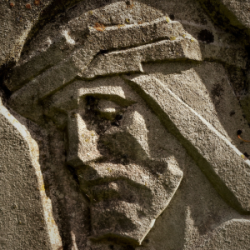Welcome readers! Please subscribe through the buttons at the right if you enjoy this post.

In Matthew’s gospel we read this story:
“When John, who was in prison, heard about the deeds of the Messiah, he sent his disciples to ask him, ‘Are you the one who is to come, or should we expect someone else?’ Jesus replied, ‘Go back and report to John what you hear and see: The blind receive sight, the lame walk, those who have leprosy are cleansed, the deaf hear, the dead are raised, and the good news is proclaimed to the poor. Blessed is anyone who does not stumble on account of me.’” (Matthew 11.2-6 cf Luke 7.18-23)
Matthew’s gospel narratives seem to be intended to lead it’s audience to embracing Jesus as Isaiah’s “one to come.”
“Then will the eyes of the blind be opened and the ears of the deaf unstopped. Then will the lame leap like a deer, and the mute tongue shout for joy. Water will gush forth in the wilderness and streams in the desert.” (Isaiah 35.5-6)
The blind regain their sight.
The lame walk around.
The skin-diseased are cleansed.
The deaf hear.
The dead are raised.
The poor receive good news.
Matthew’s Galilean Jesus must be understood on the backdrop these Jewish liberatory hopes and expectations. Yet there are two kinds of liberation here. One is physical, and the other is economic. Understanding this is one of the hooks that prevents me from simply throwing out the Jesus story. Yes, the Jesus story includes supernatural healing stories. Yet its primary focus is not Jesus the miracle worker, nor Jesus the magician, but rather the Jesus the liberator of the suffering, the poor, the oppressed, the disinherited, and the marginalized.
Liberation is the genus of his ministry, and physical healing and economic healing are two distinct species. (Too often the healing stories tend toward ableist interpretations that do harm. See The Misinformed Leading the Misinformed.)
It’s worth noting that the original Jesus followers were not postmodern, modern, or post Enlightenment people as we are. They were a product of their own times, and the Jewish world view they subscribed to most was a Jewish apocalyptic worldview. (I have written on the tenets of Jewish apocalypticism; please see An End of the World Savior versus Present Liberator.) As we’ve shared before, the apocalyptic worldview, influenced by Zoroastrianism, saw this world as the visible expression of a much larger, behind-the-scenes, cosmic conflict between forces of good and evil: earthly political and physical forces were only the extension of that cosmic conflict. Assyria, Egypt, Babylon, Greece, and Rome would all have been viewed by Jewish apocalypticists as simply the puppet-empires of YHWH’s and Israel’s cosmic enemies.
They applied this belief in cosmic war to physical illness and disabilities as well. They had no understanding of germ theory or physiology, or even the insight modern people have into anatomy. If someone was sick, for example, it was the work of unseen cosmic forces from which the person’s need was liberation. Healing, was not supernatural, but rather liberating, about an assumed relationship between a seen effect and its unseen cause.
For Jesus to be a liberator in the way that his original audience would have understood it, Jesus’ liberation had to include economic and political liberation. The fact that it also included physical healing classified Jesus as a complete liberator in an apocalyptic dualist sense as well. This would have been deeply significant in their 1st Century setting.
A Noteworthy Transition
There is a noteworthy difference in the gospels between the traditional apocalyptic liberator and the Jesus of the Jesus story, however. In Matthew’s gospel, again, John announces a coming judgment. (See Matthew 3:7-12) Just as the apocalyptic world view viewed visible agents on earth as conduits of cosmic good or evil forces, John’s statement also looked forward to a dualistic judgment where the earthly oppressed conduits of cosmic good would be vindicated and liberated while their earthly oppressors, viewed as conduits of cosmic evil, would be judged, punished and destroyed. He foresaw liberation for the oppressed but vengeance on oppressors.
The gospels show a transition from John’s more punitive liberating judgment to Jesus’s restorative liberation: for Jesus, the humanity of both the oppressed and the oppressors would be restored. (See Holding On to Our Enemies’ Humanity.)
The liberation represented in the sayings of Jesus was not simply justice for the disinherited and vengeance on their enemies, but also a liberation marked by the reparations, healing, and restoration on both sides, the subjugated as well as the subjugators. Jesus’s liberation called people away from the dehumanizing way of domination, where we endlessly create more and more effective ways of achieving power and control over others. He instead cast before our imaginations a world of restoring what had been stolen, mutual aid and resource sharing, a world where we together work to survive and then thrive as members of an interconnected human family.
When one couples this description of what the liberation of Jesus looked like—reparations, healing, restoration, liberation, and good news to the poor the point becomes stark. Jesus emerges not as a liberator wielding mass destruction on enemies, but as a liberator who works through restoration, healing, and even the nonviolent transformation of one’s enemies. It’s a humanizing liberation for all.
Granted, those who benefit from the way of domination (i.e. the dominators or those who participate in some way) don’t ever see reparations and restoration as good news today and they didn’t in Jesus’s time either. As Peter Gomes stated in his book, The Scandalous Gospel of Jesus, Jesus’s statement that “The last will be first, and the first will be last,” “is counterintuitive to our cultural presuppositions [but] is invariably good news to those who are last, and at least problematic news to those who see themselves as first” (p. 42). What is good news to the people at the bottom of the social pyramid will never be perceived as good news to those at the top.
Jesus’s liberation was also problematic to those among the people who thought violent revolution was their only hope. A nonviolent revolution did not seem very promising in the 1st Century. Though it may seem otherwise, liberation rooted in enemy love and transformation rather than the mass destruction of one’s enemies is good news.
Matthew and Luke both use the narrative of John’s disciples to connect Jesus’ liberation of the poor and oppressed with the liberation Isaiah looked forward to. Matthew includes this theme in his expansion of Mark, and Luke expands this theme even more so in his own gospel. An example of Luke’s greater emphasis on liberation is the story only found in Luke from Luke 4:16-20 where Jesus (who by all cultural expectation should have been illiterate) actually reads from Isaiah itself (cf. Isaiah 61.1-2).
For Matthew and Luke, Jesus is the long awaited arrival of the liberation that oppressed had been looking forward to since the days of Isaiah. Isaiah 35.5-6 states, “Then will the eyes of the blind be opened and the ears of the deaf unstopped. Then will the lame leap like a deer, and the mute tongue shout for joy. Water will gush forth in the wilderness and streams in the desert.” But the nature or character of Isaiah’s liberation brought its own set of challenges. One element of the liberation found in Isaiah, which would have been and still is very puzzling for many, was the image of the suffering servant.
It’s important to realize that the Jesus of the gospels is not inventing nonviolence. He is simply taking the nonviolence in Isaiah seriously. He is leaning into it, exploring where it could lead if skillfully and intentionally applied to his own day and the dynamics between Rome and the Jewish poor.
Reparation Versus Destruction
Today, we must be careful in both religious and secular settings not to describe the liberation we’re working toward as a vision of destroying people who oppose our work. Our goal is not to destroy our enemies but to include them, too, in societies transformation. They get to choose whether they will be part of that. John the Baptist’s “one to come” was a destroyer, separating humanity and bringing fire upon the chaff. But Jesus doesn’t quite line up with that description, and it causes John to question whether the people should be “looking for another.” Jesus teaches John that his liberation was quite different: it was to be a different “recompense.” Jesus’s liberating ministry is characterized by the reparations, healing, restoration and a radical change in the lives of those the status quo impoverished, for sure, but it was also to be a radical change in humanizing even the oppressors.
Rome had already made life a desert for the majority of Jewish citizens through violent oppression. Jesus did not come as another destroyer promising peace, but as a teacher showing the path toward liberation, life, and healing. He pointed the way to a world where, as Isaiah and Micah had hoped, there was enough for everyone.
“Many peoples will come and say, ‘Come, let us go up to the mountain of the LORD, to the temple of the God of Jacob. He will teach us his ways, so that we may walk in his paths.’ The law will go out from Zion, the word of the YWHW from Jerusalem. He will govern between the nations and will settle disputes for many peoples. They will beat their swords into plowshares and their spears into pruning hooks. Nation will not take up sword against nation, nor will they train for war anymore.” (Isaiah 2.3-4)
“Many nations will come and say, ‘Come, let us go up to the mountain of the LORD, to the temple of the God of Jacob. He will teach us his ways, so that we may walk in his paths.” The law will go out from Zion, the word of the LORD from Jerusalem. He will judge between many peoples and will settle disputes for strong nations far and wide. They will beat their swords into plowshares and their spears into pruning hooks. Nation will not take up sword against nation, nor will they train for war anymore. Everyone will sit under their own vine and under their own fig tree, and no one will make them afraid for the LORD Almighty has spoken. (Micah 4.2-4, emphasis added.)
This is a world that can be characterized as a safer, more just, more compassionate home for us all where all injustice, oppression and violence has been put right.
The question we return to is whether that vision cast by the Jewish Jesus in the 1st Century has any relevance to our world of corporatism, militarism, racism, bigotry, and fear. Many in Jesus’s Galilean audience desperately longed for a change from Roman imperialist tyranny. And Jesus offered a path rooted in our interconnectedness with each other; a subversive way that called us to take up the work of making our world a safer home for us all.
To each of you on this path of healing and restoration as opposed to the path of destruction: may the energy you invest in those around you be confirmed. Whatever portion of the work you are investing your time in, be of courage. Together we are making a difference in bringing liberation to the lives of those who are suffering. You’re in the right story.













